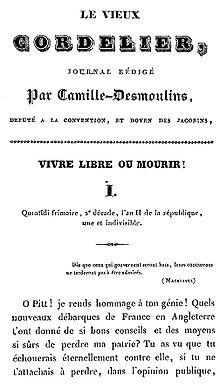Vivre Libre ou Mourir
It also appears at the top of the Journal d'État et du citoyen written and edited by Louise-Félicité de Kéralio in August 1789, whose father was the commander of the Battalion of the Filles-Saint-Thomas.
The anecdote tells that after the flight to Varennes, in the carriage which was bringing the royal family back to Paris, the Dauphin deciphered the motto engraved on the buttons of the deputy Antoine Barnave.
The phrase is also found in a note written on July 31, 1809, by General John Stark, New Hampshire's most famous soldier of the American Revolutionary War.
His poor health forced him to decline an invitation to a commemoration of the Battle of Bennington, so he sent his note by letter: However, the authorship of the motto can be disputed with Stark, the line "We must be free or die" is used by the English romantic poet William Wordsworth, in his poem "It is not to be Thought of", close to the French republicans and written during the French Revolution.
It was Alphonse Métral - who, a few years earlier, passed the war memorial of 1870-1871 every day on his way to work - who suggested this motto to Tom Morel, leader of the Maquis des Glières, which was immediately adopted.



